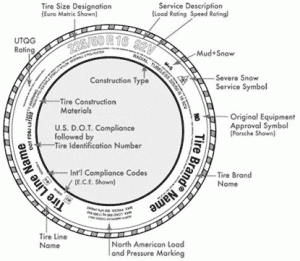by Ron Fraser in the May 2006 RootesReview:
When it comes to determining the age of a tire, it is easy to identify when a tire was manufactured by reading its tire identification code (serial number). Unlike vehicle identification numbers (VINs) that specify one particular vehicle, tire identification codes are really batch codes that identify which week and year the tire was produced.
The U.S. Department of Transportation (DOT) National Highway Traffic Safety Administration (NHTSA) require the identification code be a combination of eleven or twelve letters and numbers that identify the manufacturing location, tire size, manufacturer’s code, and week and year the tire was manufactured.
Today, the week and year the tire was manufactured is contained in the last four digits of the serial number, with the 2 digits used to identify the week a tire was manufactured immediately preceding the 2 digits used to identify the year.
Examples of tires manufactured since 2000 with this code format:
XXXXXXXX0600
06 = manufactured during the sixth week of the year
00 = manufactured during the year 2000
Tire identification codes for tires produced prior to 2000 was based on the assumption that no tire would be in service longer than ten years. They were required to provide the same information, with the week and year the tire was built contained in the last three digits. The 2 digits used to identify the week a tire was manufactured immediately preceded a single digit used to identify the year of the decade. For example, if the Tire Identification Code on a tire reads:
XXXXXXXX068
06 = manufactured during the sixth week of the year
8 = manufactured during the eighth year of the decade
While the previous serial number format identified that a tire was built in the 8th year of a decade, there was no universal identifier that confirmed which decade (tires produced in the 1990s may have a small triangle following the tire identification code to identify the decade). The tire identification code format used since 2000 accurately confirms the year.
Finally, save your sales receipts. Most tire manufacturers’ warranties cover their tires for four years from the date of purchase, or five years from the week the tires were manufactured. So if you purchase new tires that were manufactured exactly two years ago they will be covered for a total of six years (four years from the date of purchase) as long as you have your receipt. If you lose your receipt, your tires’ warranty coverage will end five years from week the tire was produced (resulting in the tire manufacturer’s warranty coverage ending only three years from the date of purchase in this example).
For more information, go to the Tire Rack tech info page on their website located at www.tirerack.com

